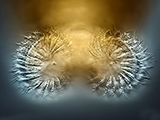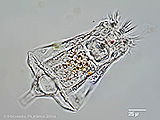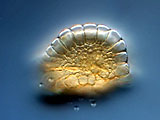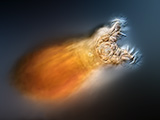|
| Rotifers of Germany and Neighbouring Countries |
|
|
| Located in the southern part of the Ruhr-District/ Germany, we are currently working on a survey of the occurence of rotifer species of Germany with emphasis on local species. The taxa presented here have been mainly identified by the works of Koste, De Smet, Nogrady, Pourriot and Segers (monogonont rotifers) and Donner (bdelloid rotifers). |
|
| |
|
| |
|
|
|
|
| |
|
| Rotifera 2 |
Ploima 1 |
Epiphanidae, Brachionidae, Euchlanidae |
| Rotifera 3 |
Ploima 2 |
Mytilinidae, Trichotriidae, Colurellidae |
| Rotifera 4 |
Ploima 3 |
Lecanidae, Proalidae, Lindiidae, |
| Rotifera 5 |
Ploima 4 |
Scariidae, Notommatidae, Trichocercidae, Gastropodidae |
| Rotifera 6 |
Ploima 5 |
Synchaetidae, Asplanchnidae, Dicranophoridae, Microcodinidae |
| Rotifera 7 |
Gnesiotrocha |
Testudinellidae, Flosculariidae, Hexarthridae, Filiniidae, Collothecidae, Conochilidae |
|
|
|
| |
|
| morphology |
 |
young persons guide to the identification of bdelloid rotifers |
|
|
|
Identification of bdelloid rotifers is not easy. There are some very good keys for the identification for example the "Key to the identification of the genera of bdelloid rotifers" by Claudia Ricci & Giulio Melone.
Of course this key and others are scientifically correct, but for the beginner maybe it is difficult to understand. There are certain traits which can be easily observed and that may help to limit the number of possible species in question or even may help to identify them. Here a selection of such traits is introduced >>>>. |
|
|
|
|
|
 |
|
 |
Frontal aspects of bdelloid rotifers |
|
|
|
It is of course a trivial thing to point out that the name of the "wheel animalcules" is derived from the "wheel-like" appearance of their front part. Although I have been dealing with this creatures for quite some time now, there are still certain phenomena that are fascinating for me, and there are also some phenomena which I still don't really understand. More on this here >>> |
|
|
|
|
|
 |
|
 |
rotifer males |
|
|
| |
In most monogonont rotifer species there is sexual dimorphism, i.e. the males look different from the females. Not only are the females larger than the males (which are called dwarf males); also their general shape may be different, and they do not have trophi, so that their identification is not easy. Because most of them are much smaller than the females they are also hard to detect or to recognize. Rotifer males develop from haploid eggs which have not bee fertilized; so the males are haploid organisms. (Females of monogonont rotifers produce three different sorts of eggs: (1) diploid amictic eggs from which amictic females hatch, (2) haploid mictic eggs that develop into diploid resting eggs if fertilized and (3) haploid mictic eggs which develop into haploid males if not fertilized.). |
| |
|
|
Here are some of them >>> |
|
|
|
|
|
|
|
 |
enigmatic rotifers |
|
|
|
Observing rotifers for more than 15 years sometimes leads to finding some specimens that are not described in the literature (as far as this literature is available through libraries) or sources from the www. A problem of these specimens is that they are single discoveries, so the don´t have scientific significance and therefore may be considered the same status like discoveries of UFO´s. Up to now I had no chance to cultivate such specimens. Nevertheless there might be the faint chance that someone has seen similar creatures, so they are presented here |
|
|
|
|
|
 |
|
| reproduction |
| |
As for the reproduction of rotifers, there are some strange peculiarities. Concerning the reproduction of rotifers there are two groups: |
| |
|
| |
the Bdelloidea or Digononta (which have two germovitellaria) reproduce exlusively asexually by ameiotic (obligate) parthenogenesis. No male bdelloid rotifers have ever been observed! |
| |
|
| |
the monogonont rotifers may reproduce either asexually by (facultative) parthenogenesis or sexually. In most monogonont rotifer species there is sexual dimorphism; rotifer males develop from haploid eggs which have not been fertilized; so the males are haploid organisms. |
| |
|
|
More on this here >>> |
|
|
|
|
|
 |
|
| |
| ecology |
 |
rotifers and parasites |
|
|
|
 |
rotifers of birdbaths and lithotelmata |
|
|
|
Bdelloid rotifers are world champions when it comes to survive desiccation. This can be demonstrated even at home if there is a garden with a bowl of water which may serve as birdbath in summer. There are some typical rotifers that can be observed in such birdbaths. Also the granite rocks of the coastal landscape of Brittany/ Francey have dents that can fill with water. (Lithotelmata). In these ephemeral puddles some special rotifers were found, whose characteristic combinatios of traits does not correspond to those of the taxa described in the literature so far. More on this here >>> |
|
|
|
|
|
 |
|
| |
 |
rotifer and predators |
|
|
|
some of the invertebrate predators are presented here >>> |
|
|
|
|
|
 |
|
| |
| |
| techniques |
 |
trophi analysis |
|
|
|
| |
| |
| |
| |
|
|
|
|
|
|
|